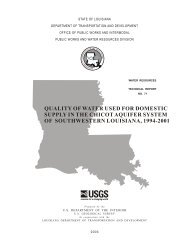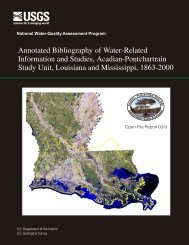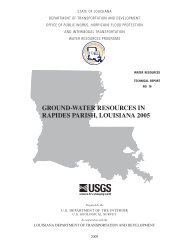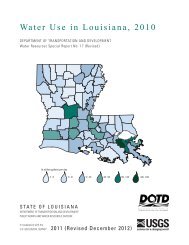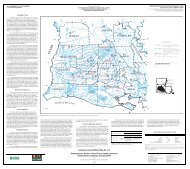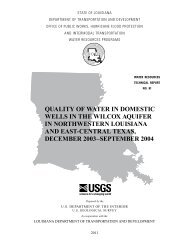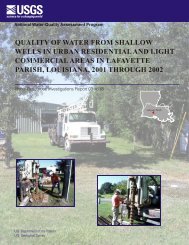environmental setting, water quality, and ecological indicators of
environmental setting, water quality, and ecological indicators of
environmental setting, water quality, and ecological indicators of
You also want an ePaper? Increase the reach of your titles
YUMPU automatically turns print PDFs into web optimized ePapers that Google loves.
FOREWORD<br />
The U.S. Geological Survey (USGS) is committed<br />
to serve the Nation with accurate <strong>and</strong> timely scientific<br />
information that helps enhance <strong>and</strong> protect the<br />
overall <strong>quality</strong> <strong>of</strong> life, <strong>and</strong> facilitates effective management<br />
<strong>of</strong> <strong>water</strong>, biological, energy, <strong>and</strong> mineral<br />
resources. Information on the <strong>quality</strong> <strong>of</strong> the Nation’s<br />
<strong>water</strong> resources is <strong>of</strong> critical interest to the USGS<br />
because it is so integrally linked to the long-term<br />
availability <strong>of</strong> <strong>water</strong> that is clean <strong>and</strong> safe for drinking<br />
<strong>and</strong> recreation <strong>and</strong> that is suitable for industry,<br />
irrigation, <strong>and</strong> habitat for fish <strong>and</strong> wildlife. Escalating<br />
population growth <strong>and</strong> increasing dem<strong>and</strong>s for<br />
the multiple <strong>water</strong> uses make <strong>water</strong> availability, now<br />
measured in terms <strong>of</strong> quantity <strong>and</strong> <strong>quality</strong>, even<br />
more critical to the long-term sustainability <strong>of</strong> our<br />
communities <strong>and</strong> ecosystems.<br />
The USGS implemented the National Water-Quality<br />
Assessment (NAWQA) Program to support<br />
national, regional, <strong>and</strong> local information needs <strong>and</strong><br />
decisions related to <strong>water</strong>-<strong>quality</strong> management <strong>and</strong><br />
policy. Shaped by <strong>and</strong> coordinated with ongoing<br />
efforts <strong>of</strong> other Federal, State, <strong>and</strong> local agencies,<br />
the NAWQA Program is designed to answer: What<br />
is the condition <strong>of</strong> our Nation’s streams <strong>and</strong> ground<br />
<strong>water</strong>? How are the conditions changing over time?<br />
How do natural features <strong>and</strong> human activities affect<br />
the <strong>quality</strong> <strong>of</strong> streams <strong>and</strong> ground <strong>water</strong>, <strong>and</strong> where<br />
are those effects most pronounced? By combining<br />
information on <strong>water</strong> chemistry, physical characteristics,<br />
stream habitat, <strong>and</strong> aquatic life, the NAWQA<br />
Program aims to provide science-based insights for<br />
current <strong>and</strong> emerging <strong>water</strong> issues. NAWQA<br />
results can contribute to informed decisions that<br />
result in practical <strong>and</strong> effective <strong>water</strong>-resource management<br />
<strong>and</strong> strategies that protect <strong>and</strong> restore <strong>water</strong><br />
<strong>quality</strong>.<br />
Since 1991, the NAWQA Program has implemented<br />
interdisciplinary assessments in more than<br />
50 <strong>of</strong> the Nation’s most important river basins <strong>and</strong><br />
aquifers, referred to as Study Units. Collectively,<br />
these Study Units account for more than 60 percent<br />
<strong>of</strong> the overall <strong>water</strong> use <strong>and</strong> population served by<br />
public <strong>water</strong> supply, <strong>and</strong> are representative <strong>of</strong> the<br />
Nation’s major hydrologic l<strong>and</strong>scapes, priority eco-<br />
logical resources, <strong>and</strong> agricultural, urban, <strong>and</strong> natural<br />
sources <strong>of</strong> contamination.<br />
Each assessment is guided by a nationally consistent<br />
study design <strong>and</strong> methods <strong>of</strong> sampling <strong>and</strong> analysis.<br />
The assessments thereby build local<br />
knowledge about <strong>water</strong>-<strong>quality</strong> issues <strong>and</strong> trends in<br />
a particular stream or aquifer while providing an<br />
underst<strong>and</strong>ing <strong>of</strong> how <strong>and</strong> why <strong>water</strong> <strong>quality</strong> varies<br />
regionally <strong>and</strong> nationally. The consistent, multiscale<br />
approach helps to determine if certain types <strong>of</strong><br />
<strong>water</strong>-<strong>quality</strong> issues are isolated or pervasive, <strong>and</strong><br />
allows direct comparisons <strong>of</strong> how human activities<br />
<strong>and</strong> natural processes affect <strong>water</strong> <strong>quality</strong> <strong>and</strong> <strong>ecological</strong><br />
health in the Nation’s diverse geographic <strong>and</strong><br />
<strong>environmental</strong> <strong>setting</strong>s. Comprehensive assessments<br />
on pesticides, nutrients, volatile organic compounds,<br />
trace metals, <strong>and</strong> aquatic ecology are<br />
developed at the national scale through comparative<br />
analysis <strong>of</strong> the Study-Unit findings.<br />
The USGS places high value on the communication<br />
<strong>and</strong> dissemination <strong>of</strong> credible, timely, <strong>and</strong> relevant<br />
science so that the most recent <strong>and</strong> available knowledge<br />
about <strong>water</strong> resources can be applied in management<br />
<strong>and</strong> policy decisions. We hope this<br />
NAWQA publication will provide you the needed<br />
insights <strong>and</strong> information to meet your needs, <strong>and</strong><br />
thereby foster increased awareness <strong>and</strong> involvement<br />
in the protection <strong>and</strong> restoration <strong>of</strong> our<br />
Nation’s <strong>water</strong>s.<br />
The NAWQA Program recognizes that a national<br />
assessment by a single program cannot address all<br />
<strong>water</strong>-resource issues <strong>of</strong> interest. External coordination<br />
at all levels is critical for a fully integrated<br />
underst<strong>and</strong>ing <strong>of</strong> <strong>water</strong>sheds <strong>and</strong> for cost-effective<br />
management, regulation, <strong>and</strong> conservation <strong>of</strong> our<br />
Nation’s <strong>water</strong> resources. The Program, therefore,<br />
depends extensively on the advice, cooperation, <strong>and</strong><br />
information from other Federal, State, interstate,<br />
Tribal, <strong>and</strong> local agencies, non-government organizations,<br />
industry, academia, <strong>and</strong> other stakeholder<br />
groups. The assistance <strong>and</strong> suggestions <strong>of</strong> all are<br />
greatly appreciated.<br />
Robert M. Hirsch<br />
Associate Director for Water



